八大行星英语表达
最常见的天文英语词汇
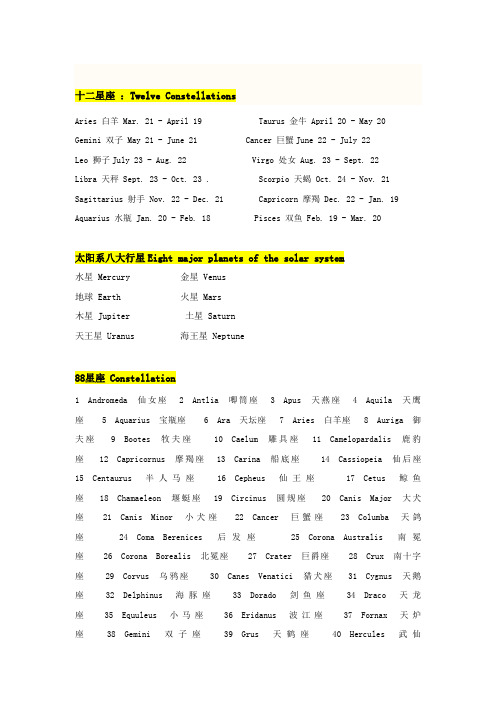
十二星座:Twelve ConstellationsAries 白羊 Mar. 21 - April 19 Taurus 金牛 April 20 - May 20 Gemini 双子 May 21 - June 21 Cancer 巨蟹June 22 - July 22Leo 狮子July 23 - Aug. 22 Virgo 处女 Aug. 23 - Sept. 22Libra 天秤 Sept. 23 - Oct. 23 . Scorpio 天蝎 Oct. 24 - Nov. 21 Sagittarius 射手 Nov. 22 - Dec. 21 Capricorn 摩羯 Dec. 22 - Jan. 19 Aquarius 水瓶 Jan. 20 - Feb. 18 Pisces 双鱼 Feb. 19 - Mar. 20太阳系八大行星Eight major planets of the solar system水星 Mercury 金星 Venus地球 Earth 火星 Mars木星 Jupiter 土星 Saturn天王星 Uranus 海王星 Neptune88星座 Constellation1 Andromeda 仙女座2 Antlia 唧筒座3 Apus 天燕座4 Aquila 天鹰座5 Aquarius 宝瓶座6 Ara 天坛座7 Aries 白羊座8 Auriga 御夫座9 Bootes 牧夫座10 Caelum 雕具座11 Camelopardalis 鹿豹座12 Capricornus 摩羯座13 Carina 船底座14 Cassiopeia 仙后座15 Centaurus 半人马座16 Cepheus 仙王座17 Cetus 鲸鱼座18 Chamaeleon 堰蜓座19 Circinus 圆规座20 Canis Major 大犬座21 Canis Minor 小犬座22 Cancer 巨蟹座23 Columba 天鸽座24 Coma Berenices 后发座25 Corona Australis 南冕座 26 Corona Borealis 北冕座 27 Crater 巨爵座 28 Crux 南十字座29 Corvus 乌鸦座30 Canes Venatici 猎犬座31 Cygnus 天鹅座32 Delphinus 海豚座33 Dorado 剑鱼座34 Draco 天龙座35 Equuleus 小马座36 Eridanus 波江座37 Fornax 天炉座38 Gemini 双子座39 Grus 天鹤座40 Hercules 武仙座41 Horologium 时钟座42 Hydra 长蛇座43 Hydrus 水蛇座44 Indus 印地安座45 Lacerta 蝎虎座46 Leo 狮子座47 Lepus 天兔座48 Libra 天秤座49 Leo Minor 小狮座 50 Lupus 豺狼座 51 Lynx 天猫座 52 Lyra 天琴座 53 Mensa 山案座54 Microscopium 显微镜座55 Monocers 麒麟座56 Musca 苍蝇座57 Norma 矩尺座58 Octans 南极座59 Ophiuchus 蛇夫座60 Orion 猎户座61 Pavo 孔雀座62 Pegasus 飞马座63 Perseus 英仙座64 Phoenix 凤凰座65 Pictor 绘架座66 Piscis Australis 南鱼座67 Pisces 双鱼座68 Puppis 船舻座69 Pyxis 罗盘座70 Reticulum 网罟座71 Sculptor 玉夫座72 Scorpius 天蝎座73 Scutum 盾牌座74 Serpens 巨蛇座75 Sextans 六分仪座76 Sagitta 天箭座77 Sagittarius 人马座78 Taurus 金牛座79 Telescopium 望远镜座80 Triangulum Australe 南三角座81 Triangulum 三角座82 Tucana 杜鹃座83 Ursa Major 大熊座84 Ursa Minor 小熊座85 Vela 船帆座86 Virgo 处女座87 Volans 飞鱼座 88 Vulpecula 狐狸座其他词汇望远镜telescope [ˈteliskəup] 双筒望远镜binoculars[baiˈnɔkjuləz]反射式望远镜reflecting telescope [ri'flektiŋ]折射式望远镜牛顿式反射望远镜Newtonian reflector 天区Sky coverage星系galaxy [ˈgæləkəsi] 恒星star [stɑ:]行星planet [ˈplænit] 卫星satellite [ˈsætəlait] 星云nebula [ˈnebjulə] 银河the Milky Way类木行星:四大行星之一:木星、土星、天王星、海王星:Jovian planet :Any of the four largest planets: Jupiter, Saturn, Uranus, and Neptune.星云、星团新总表(简称NGC)New General Catalogue (NGC)太阳活动solar activity 太阳风solar wind太阳活动周solar cycle 太阳耀斑solar flare白矮星White dwarf 红巨星red giant主星系dominant galaxy 球状星系spherical galaxy旋涡星系spiral galaxy 椭圆星系elliptical galaxy不规则星系irregular galaxy 河外星系Extragalactic开普勒定律Kepler's laws 光年light year近地小行星earth-approaching asteroid近地天体earth-approaching object太阳系外行星extrasolar planet太阳系外行星系extrasolar planetary system地外智慧生物extraterrestrial intelligence不明飞行物(UFO) Unidentified Flying Object哈勃空间望远镜HST, Hubble Space Telescope国际空间站 International Space Station美国航天局NASA(National Aeronautics and Space Administration)中国航天局CNSA(China National Space Administration)狭义相对论special theory of relativity木星环Jovian ring 海王星环Nepturian ring天王星环 Uranian ring 疏散星团open cluster星际尘埃interstellar dust 星际气体interstellar gas大气视宁度atmospheric seeing 光污染light pollution近地小行星near-earth asteroi 近地小行星带near-earth asteroid belt小行星asteroid (minor planet) 小行星带asteroid belt近地彗星near-earth comet 近地天体NEO, near-earth object环食带path of annularity 光感 light sensation全食total eclipse 偏食partial eclipse 近日点perihelion 近地点perigee远日点aphelion 远地点apogee残月waning crescent 亏凸月waning gibbous娥眉月waxing crescent 盈凸月waxing gibbous满月full moon 月相phases (of the Moon)轨道orbit 新星novaastronaut 航天员 capsule 太空舱carrier rocket 运载火箭 artificial satellite 人造卫星launch a satellite 发射卫星 low Earth orbit 近地轨道manned space 载人航天计划 manned space flight 载人航天manned spaceship/ spacecraft 载人飞船 orbit the earth 绕地球飞行outer space; deep space 外太空 space shuttle 航天飞机unmanned spaceship / spacecraft 无人飞船 weather satellite 气象卫星black holes 黑洞 pulsar 脉冲星绝对星等absolute magnitude 极限星等limiting magnitude流星Meteor 流星雨meteor shower反物质antimatter 天文学astronomy极光aurora 天体物理学astrophysics宇宙大爆炸Big Bang 双星binary star天极celestial poles 天球celestial sphere目镜eyepiece 物镜objective len /objective glass(1) 行星(2) 恒星和星云(3) 银河系及河外星系4) 星系团超星系团大尺度结构。
最常见的天文英语词汇
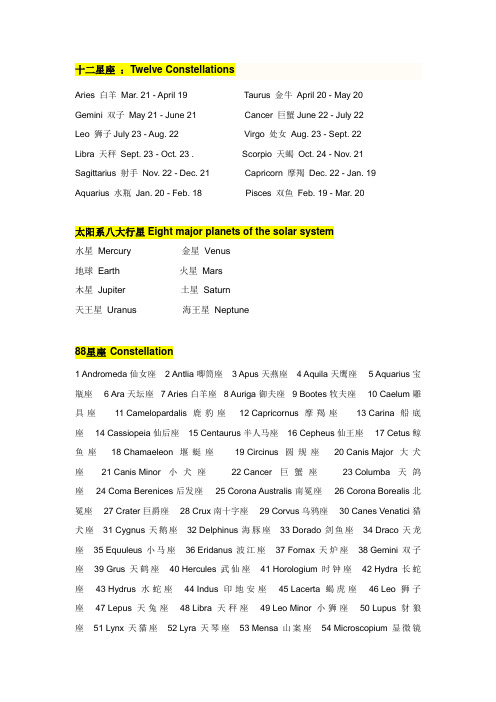
十二星座:Twelve ConstellationsAries 白羊Mar. 21 - April 19 Taurus 金牛April 20 - May 20Gemini 双子May 21 - June 21 Cancer 巨蟹June 22 - July 22Leo 狮子July 23 - Aug. 22 Virgo 处女Aug. 23 - Sept. 22Libra 天秤Sept. 23 - Oct. 23 . Scorpio 天蝎Oct. 24 - Nov. 21Sagittarius 射手Nov. 22 - Dec. 21 Capricorn 摩羯Dec. 22 - Jan. 19Aquarius 水瓶Jan. 20 - Feb. 18 Pisces 双鱼Feb. 19 - Mar. 20太阳系八大行星Eight major planets of the solar system水星Mercury 金星Venus地球Earth 火星Mars木星Jupiter 土星Saturn天王星Uranus 海王星Neptune88星座 Constellation1 Andromeda 仙女座2 Antlia 唧筒座3 Apus 天燕座4 Aquila 天鹰座5 Aquarius 宝瓶座6 Ara 天坛座7 Aries 白羊座8 Auriga 御夫座9 Bootes 牧夫座10 Caelum 雕具座11 Camelopardalis 鹿豹座12 Capricornus 摩羯座13 Carina 船底座14 Cassiopeia 仙后座15 Centaurus 半人马座16 Cepheus 仙王座17 Cetus 鲸鱼座18 Chamaeleon 堰蜓座19 Circinus 圆规座20 Canis Major 大犬座21 Canis Minor 小犬座22 Cancer 巨蟹座23 Columba 天鸽座24 Coma Berenices 后发座25 Corona Australis 南冕座26 Corona Borealis 北冕座27 Crater 巨爵座28 Crux 南十字座29 Corvus 乌鸦座30 Canes Venatici 猎犬座31 Cygnus 天鹅座32 Delphinus 海豚座33 Dorado 剑鱼座34 Draco 天龙座35 Equuleus 小马座36 Eridanus 波江座37 Fornax 天炉座38 Gemini 双子座39 Grus 天鹤座40 Hercules 武仙座41 Horologium 时钟座42 Hydra 长蛇座43 Hydrus 水蛇座44 Indus 印地安座45 Lacerta 蝎虎座46 Leo 狮子座47 Lepus 天兔座48 Libra 天秤座49 Leo Minor 小狮座50 Lupus 豺狼座51 Lynx 天猫座52 Lyra 天琴座53 Mensa 山案座54 Microscopium 显微镜座55 Monocers 麒麟座56 Musca 苍蝇座57 Norma 矩尺座58 Octans 南极座59 Ophiuchus 蛇夫座60 Orion 猎户座61 Pavo 孔雀座62 Pegasus 飞马座63 Perseus 英仙座64 Phoenix 凤凰座65 Pictor 绘架座66 Piscis Australis 南鱼座67 Pisces 双鱼座68 Puppis 船舻座69 Pyxis 罗盘座70 Reticulum 网罟座71 Sculptor 玉夫座72 Scorpius 天蝎座73 Scutum 盾牌座74 Serpens 巨蛇座75 Sextans 六分仪座76 Sagitta 天箭座77 Sagittarius 人马座78 Taurus 金牛座79 Telescopium 望远镜座80 Triangulum Australe 南三角座81 Triangulum 三角座82 Tucana 杜鹃座83 Ursa Major 大熊座84 Ursa Minor 小熊座85 Vela 船帆座86 Virgo 处女座87 Volans 飞鱼座88 Vulpecula 狐狸座其他词汇望远镜telescope [ˈteliskəup] 双筒望远镜binoculars [baiˈnɔkjuləz]反射式望远镜reflecting telescope [ri'flektiŋ]折射式望远镜牛顿式反射望远镜Newtonian reflector 天区Sky coverage星系galaxy [ˈgæləkəsi] 恒星star [stɑ:]行星planet [ˈplænit] 卫星satellite [ˈsætəlait]星云nebula [ˈnebjulə] 银河the Milky Way类木行星:四大行星之一:木星、土星、天王星、海王星:Jovian planet :Any of the four largest planets: Jupiter, Saturn, Uranus, and Neptune. 星云、星团新总表(简称NGC)New General Catalogue (NGC)太阳活动solar activity 太阳风solar wind太阳活动周solar cycle 太阳耀斑solar flare白矮星White dwarf 红巨星red giant主星系dominant galaxy 球状星系spherical galaxy旋涡星系spiral galaxy 椭圆星系elliptical galaxy不规则星系irregular galaxy 河外星系Extragalactic开普勒定律Kepler's laws 光年light year近地小行星earth-approaching asteroid近地天体earth-approaching object太阳系外行星extrasolar planet太阳系外行星系extrasolar planetary system地外智慧生物extraterrestrial intelligence不明飞行物(UFO) Unidentified Flying Object哈勃空间望远镜HST, Hubble Space Telescope国际空间站International Space Station美国航天局NASA(National Aeronautics and Space Administration)中国航天局CNSA(China National Space Administration)狭义相对论special theory of relativity木星环Jovian ring 海王星环Nepturian ring天王星环Uranian ring 疏散星团open cluster星际尘埃interstellar dust 星际气体interstellar gas大气视宁度atmospheric seeing 光污染light pollution近地小行星near-earth asteroi 近地小行星带near-earth asteroid belt 小行星asteroid (minor planet) 小行星带asteroid belt近地彗星near-earth comet 近地天体NEO, near-earth object环食带path of annularity 光感light sensation全食total eclipse 偏食partial eclipse近日点perihelion 近地点perigee远日点aphelion 远地点apogee残月waning crescent 亏凸月waning gibbous娥眉月waxing crescent 盈凸月waxing gibbous满月full moon 月相phases (of the Moon)轨道orbit 新星novaastronaut 航天员capsule 太空舱carrier rocket 运载火箭artificial satellite 人造卫星launch a satellite 发射卫星low Earth orbit 近地轨道manned space 载人航天计划manned space flight 载人航天manned spaceship/ spacecraft 载人飞船orbit the earth 绕地球飞行outer space; deep space 外太空space shuttle 航天飞机unmanned spaceship / spacecraft 无人飞船weather satellite 气象卫星black holes 黑洞pulsar 脉冲星绝对星等absolute magnitude 极限星等limiting magnitude流星Meteor 流星雨meteor shower反物质antimatter 天文学astronomy极光aurora 天体物理学astrophysics宇宙大爆炸Big Bang 双星binary star天极celestial poles 天球celestial sphere目镜eyepiece 物镜objective len /objective glass。
八大行星英语名字由来

太阳系八大行星,英文及命名解释Solar System and Planets墨丘利(维纳斯地球)马尔斯(朱庇特萨图恩)(乌拉诺斯尼普顿)普鲁托汉语中,八大行星有5颗以“金木水火土”五行命名,其他为翻译。
英语中,以古罗马及希腊诸神命名。
太阳系,Solar System太阳Sun水星Mercury,小写m为水银,汞。
罗马神话中的墨丘利神,众神的信使,掌管商业。
墨丘利[Mercury]古罗马宗教所信奉的商贾之神,一般认为相当于希腊众神信使赫耳墨斯。
位于罗马阿文丁山的神殿落成于公元前495年。
女神迈亚被认为是他的母亲,母子两神同在5月15日的节日受奉祀。
墨丘利有时被描绘作手握钱囊,象征其司掌商业。
更多的时候他被赋予了赫耳墨斯的特征,也穿带翼靸鞋或戴有翼之帽,且手执节杖。
墨丘利,戴有翼之帽、执杖的古典雕像;现藏佛罗伦萨的乌菲齐美术馆。
Alinari--Art Resource金星Venus,维纳斯,古罗马女神,掌管农田和园林,象征爱情和女性美。
朱庇特(Jupiter)之女,丘比特(Cupid)之母。
补充:爱神丘比特,通常为生有双翅的男童,手执弓箭,其父即为水星墨丘利。
金星启明星Venus古罗马女神,司掌农田和园林,后来认为她就是司掌爱情的希腊女神阿佛洛狄忒。
朱庇特和狄俄涅之女,伏尔甘之妻、丘比特之母。
维纳斯象征爱情和女性美,自古就是重要艺术题材,著名的维纳斯像包括《米洛的维纳斯》和S.波提切利所画《维纳斯的诞生》。
火星Mars,古罗马神话中的战神马尔斯,重要性仅次于主神朱庇特马尔斯[Mars]古罗马战神和罗马的守护神,其重要性仅次于主神朱庇特。
纪念他的节日是在春天(3月)和秋天(10月)。
奥古斯都时期,罗马只有两座马尔斯神庙。
他的圣矛保存在圣所,战争爆发时,罗马执政官必须摇动圣矛说“马尔斯,醒过来”。
在奥古斯都统治时期,马尔斯不仅成为罗马军事的保护人,也是皇帝的保护人。
他在希腊神话中同阿瑞斯神。
木星Jupiter,古罗马神话中的主神朱庇特,相当于希腊神话的宙斯。
太阳系八大行星的英语

太阳系八大行星的英语The Eight Planets of the Solar SystemIntroduction:The solar system consists of the sun and a group of celestial bodies that orbit around it. There are eight major planets in our solar system, each with its own unique characteristics and properties. In this document, we will provide an overview of the eight planets, their composition, physical features, and interesting facts.1. Mercury:Mercury is the smallest planet in the solar system and closest to the sun. It has a rocky surface with numerous craters caused by meteorite impacts. Due to its proximity to the sun, temperatures on Mercury can reach extreme highs during the day and drop significantly at night. It does not have an atmosphere and has a very thin layer of gases surrounding it.2. Venus:Venus is often referred to as Earth's sister planet due to its similar size and composition. It is the hottest planet in our solar system, with a thick atmosphere that traps the sun's heat, leading to a runaway greenhouse effect. Venus is covered in thick clouds composed mainly of sulfuric acid, making its surface hidden from view.3. Earth:Our home planet, Earth, is the third planet from the sun and the only known planet to support life. It has a diverserange of ecosystems, including oceans, mountains, forests, and deserts. Earth has an atmosphere consisting of mainly nitrogen and oxygen, which helps to regulate temperatures and preserve life. It is also the only planet to have liquid water on its surface.4. Mars:Mars, often referred to as the "Red Planet," is known for its reddish appearance due to iron oxide, also known as rust, covering its surface. Mars has polar ice caps, similar to Earth's, and evidence of ancient rivers and lakes. It has a thin atmosphere consisting mainly of carbon dioxide. Scientists continue to study Mars for signs of past or present life.5. Jupiter:Jupiter is the largest planet in our solar system and is primarily composed of hydrogen and helium. It is known for its distinctive bands of clouds and the Great Red Spot, a massive storm that has been raging for hundreds of years. Jupiter has numerous moons, with the four largest ones known as the Galilean moons: Io, Europa, Ganymede, and Callisto.6. Saturn:Saturn is recognized for its beautiful ring system, composed of ice and rock particles. It is the second-largest planet and mainly consists of hydrogen and helium. Saturn's rings are made up of thousands of individual ringlets that vary in size and thickness. Like Jupiter, Saturn has numerous moons, with Titan being the largest and most interesting due to its thick atmosphere and potential for supporting life.7. Uranus:Uranus is a unique planet in our solar system, known for its sideways orientation. It is composed mainly ofhydrogen and helium, along with small amounts of water, methane, and ammonia. Uranus has a bluish-green appearance due to the presence of methane in its atmosphere. It has a system of rings, but they are much fainter and narrower compared to Saturn's.8. Neptune:Neptune is the farthest planet from the sun and one of the windiest places in the solar system. It is composed mainly of hydrogen and helium, with traces of methane giving it a blue color. Neptune has a distinct feature called the Great Dark Spot, similar to Jupiter's Great Red Spot. It has a system of rings, but they are very faint and difficult to observe.Conclusion:The eight planets of our solar system offer a diverse range of compositions, physical features, and interesting facts. From the scorching hot Venus to the windy and distant Neptune, each planet provides us with valuable information about the formation and evolution of our solar system. Although we have yet to fully explore and understand these fascinating celestial bodies, ongoing research and exploration continue to unveil new discoveries and broaden our knowledge of the solar system.。
太阳系八大行星的英文名称

太阳系八大行星的英文名称The Eight Planets of Our Solar System: An Explorationof Their English Names.Our solar system is home to eight planets, each withits unique characteristics and place in celestial hierarchy. From the scorching inferno of Mercury closest to the Sun to the icy realms of Neptune at the outer reaches of the solar system, these planets have captivated the human imagination for centuries. Their names, derived from Greek and Roman mythology, serve as a testament to the cultural andscientific heritage that has shaped our understanding ofthe universe.1. Mercury (closest to the Sun)。
Named after the Roman god of swiftness and trade, Mercury lives up to its namesake as the smallest andfastest-moving planet in our solar system. Its proximity to the Sun subjects it to intense heat and solar radiation,making it a barren and inhospitable world.2. Venus.Venus, named after the Roman goddess of love and beauty, is the second planet from the Sun. Its thick, carbondioxide-rich atmosphere traps heat, creating a runaway greenhouse effect that makes Venus the hottest planet inour solar system.3. Earth.Our home planet, Earth, is the third from the Sun and the only known planet in the universe that can sustain life. Its unique combination of liquid water, a breathable atmosphere, and a stable climate has made it a thriving haven for countless species.4. Mars.Named after the Roman god of war, Mars is oftenreferred to as the "Red Planet" due to its iron oxide-richsurface. Once thought to be potentially habitable, Mars is now known to be a cold, dry world with a thin atmosphere and no evidence of liquid water on its surface.5. Jupiter.The largest planet in our solar system, Jupiter is a gas giant named after the Roman king of the gods. Its swirling, banded atmosphere is dominated by giant storms, including the Great Red Spot, an anticyclone that has been raging for centuries.6. Saturn.Saturn, named after the Roman god of agriculture, is another gas giant renowned for its stunning ring system. Composed of countless ice particles and smaller bodies, Saturn's rings are a mesmerizing sight that has inspired awe and wonder for ages.7. Uranus.Named after the Greek god of the sky, Uranus is a unique planet that rotates on its side. This unusual tilt gives it extreme seasonal variations, with one pole experiencing decades of continuous daylight while the other endures years of darkness.8. Neptune.The farthest planet from the Sun, Neptune is namedafter the Roman god of the sea. Its blue-green appearance is caused by the absorption of red light by methane in its atmosphere. Neptune's most notable feature is its Great Dark Spot, a storm system that rivaled the Great Red Spot on Jupiter for size and intensity.The Symphony of Celestial Names.The names of the planets in our solar system are not merely arbitrary labels but reflect the cultural and scientific heritage that has shaped our understanding of the universe. They are a testament to the human fascination with the cosmos and a reminder that even in the vastexpanse of space, we seek to impose order and meaning through language and mythology.The symphony of celestial names echoes through the annals of astronomy, connecting us to the ancient civilizations that first gazed up at the night sky and saw not only celestial bodies but also figures of gods and goddesses. These names serve as a timeless bridge between the human imagination and the infinite mysteries of the cosmos.。
太阳系八大行星中英文
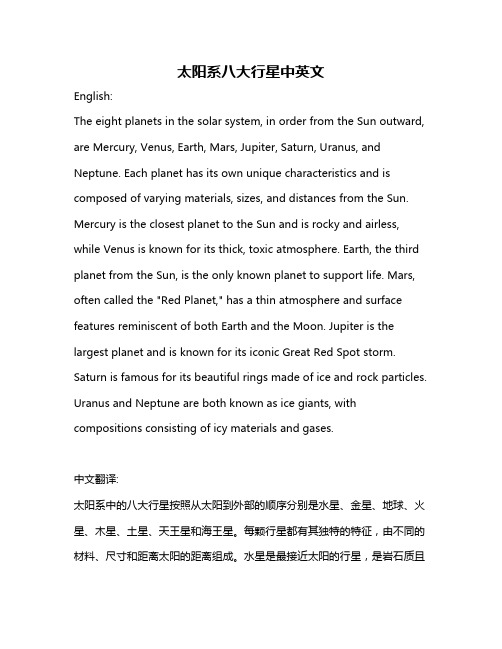
太阳系八大行星中英文English:The eight planets in the solar system, in order from the Sun outward, are Mercury, Venus, Earth, Mars, Jupiter, Saturn, Uranus, and Neptune. Each planet has its own unique characteristics and is composed of varying materials, sizes, and distances from the Sun. Mercury is the closest planet to the Sun and is rocky and airless, while Venus is known for its thick, toxic atmosphere. Earth, the third planet from the Sun, is the only known planet to support life. Mars, often called the "Red Planet," has a thin atmosphere and surface features reminiscent of both Earth and the Moon. Jupiter is the largest planet and is known for its iconic Great Red Spot storm. Saturn is famous for its beautiful rings made of ice and rock particles. Uranus and Neptune are both known as ice giants, with compositions consisting of icy materials and gases.中文翻译:太阳系中的八大行星按照从太阳到外部的顺序分别是水星、金星、地球、火星、木星、土星、天王星和海王星。
简述太阳系中八大行星及其对应的英文名
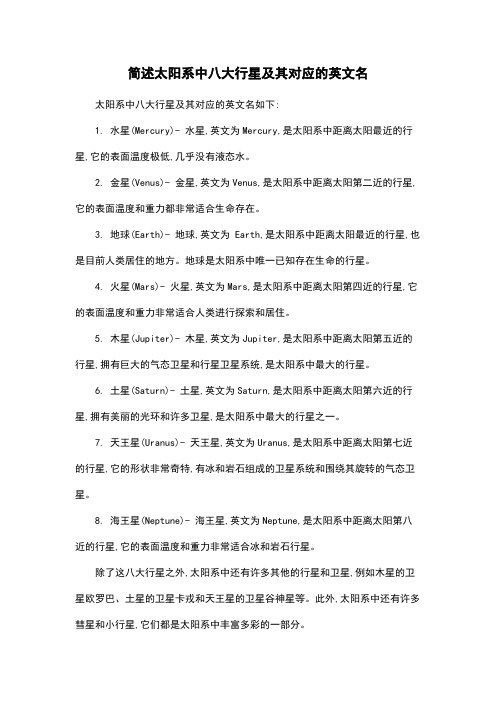
简述太阳系中八大行星及其对应的英文名太阳系中八大行星及其对应的英文名如下:
1. 水星(Mercury)- 水星,英文为Mercury,是太阳系中距离太阳最近的行星,它的表面温度极低,几乎没有液态水。
2. 金星(Venus)- 金星,英文为Venus,是太阳系中距离太阳第二近的行星,它的表面温度和重力都非常适合生命存在。
3. 地球(Earth)- 地球,英文为 Earth,是太阳系中距离太阳最近的行星,也是目前人类居住的地方。
地球是太阳系中唯一已知存在生命的行星。
4. 火星(Mars)- 火星,英文为Mars,是太阳系中距离太阳第四近的行星,它的表面温度和重力非常适合人类进行探索和居住。
5. 木星(Jupiter)- 木星,英文为Jupiter,是太阳系中距离太阳第五近的行星,拥有巨大的气态卫星和行星卫星系统,是太阳系中最大的行星。
6. 土星(Saturn)- 土星,英文为Saturn,是太阳系中距离太阳第六近的行星,拥有美丽的光环和许多卫星,是太阳系中最大的行星之一。
7. 天王星(Uranus)- 天王星,英文为Uranus,是太阳系中距离太阳第七近的行星,它的形状非常奇特,有冰和岩石组成的卫星系统和围绕其旋转的气态卫星。
8. 海王星(Neptune)- 海王星,英文为Neptune,是太阳系中距离太阳第八近的行星,它的表面温度和重力非常适合冰和岩石行星。
除了这八大行星之外,太阳系中还有许多其他的行星和卫星,例如木星的卫星欧罗巴、土星的卫星卡戎和天王星的卫星谷神星等。
此外,太阳系中还有许多彗星和小行星,它们都是太阳系中丰富多彩的一部分。
太阳系和9大行星的英文介绍
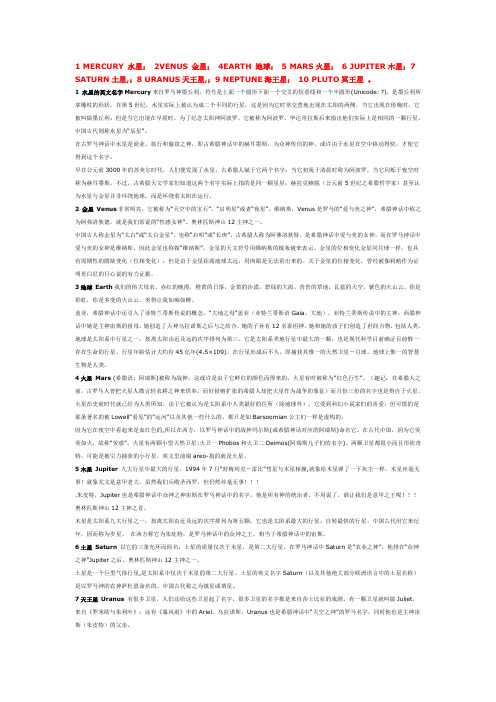
1 MERCURY水星;2VENUS金星;4EARTH地球;5 MARS火星;6 JUPITER木星;7 SATURN土星,;8 URANUS天王星,;9 NEPTUNE海王星;10 PLUTO冥王星。
1水星的英文名字Mercury来自罗马神墨丘利。
符号是上面一个圆形下面一个交叉的短垂线和一个半圆形(U nic ode: ?). 是墨丘利所拿魔杖的形状。
在第5世纪,水星实际上被认为成二个不同的行星,这是因为它时常交替地出现在太阳的两侧。
当它出现在傍晚时,它被叫做墨丘利;但是当它出现在早晨时,为了纪念太阳神阿波罗,它被称为阿波罗。
毕达哥拉斯后来指出他们实际上是相同的一颗行星。
中国古代则称水星为“辰星”。
在古罗马神话中水星是商业、旅行和偷窃之神,即古希腊神话中的赫耳墨斯,为众神传信的神,或许由于水星在空中移动得快,才使它得到这个名字。
早在公元前3000年的苏美尔时代,人们便发现了水星,古希腊人赋于它两个名字:当它初现于清晨时称为阿波罗,当它闪烁于夜空时称为赫耳墨斯。
不过,古希腊天文学家们知道这两个名字实际上指的是同一颗星星,赫拉克赖脱(公元前5世纪之希腊哲学家)甚至认为水星与金星并非环绕地球,而是环绕着太阳在运行。
2金星Venus非常明亮,它被称为“天空中的宝石”,“启明星”或者“夜星”。
维纳斯,V enus是罗马的“爱与美之神”,希腊神话中称之为阿弗洛狄德,就是我们常说的“性感女神”。
奥林匹斯神山12主神之一。
中国古人称金星为“太白”或“太白金星”,也称“启明”或“长庚”。
古希腊人称为阿佛洛狄特,是希腊神话中爱与美的女神。
而在罗马神话中爱与美的女神是维纳斯,因此金星也称做“维纳斯”。
金星的天文符号用维纳斯的梳妆镜来表示。
金星的位相变化金星同月球一样,也具有周期性的圆缺变化(位相变化),但是由于金星距离地球太远,用肉眼是无法看出来的。
关于金星的位相变化,曾经被伽利略作为证明哥白尼的日心说的有力证据。
八大行星及相对应的英语

八大行星:离太阳的距离从小到大依次为水星(Mercury)、金星(Venus)、地球(Earth)、火星(Mars)、木星(Jupiter)、土星(Saturn)、天王星(Uranus)、海王星(Neptune)这八大行星。
1 水星(Mercury)水星是最靠近太阳的,也是最小的行星。
2 金星(Venus)按离太阳由近及远的次序是第二颗。
但它是离地球最近的行星。
3 地球(Earth)地球是太阳系从内到外的第三颗行星,地球是一个两极略扁的不规则椭球体,是目前最适合人类居住的星球。
4火星(Mars)火星(mars)是距太阳第4近的行星,火星比地球小。
5木星(Jupiter)木星是太阳系最大的行星。
6土星(Saturn)7天王星(Uranus)8海王星(Neptune)小学六年级英语语法一、基数词,序数词序数词前一定要加“the”,序数词一般用于:①日期【the 号(序数词)of 月】②【第几…】③【名次】二、动词1. be动词(am/is/are)主语be动词(原形)be动词(过去式)I am was He/she/it is wasWe/you/they are were2.助动词(do/does/did)问句答句Do+非第三人称单数+动词原形…?…do/don’tDoes+第三人称单数…does/doesn’tDid+所有主格…did/didn’t问句答句What do you/they/we…+动词原形?I/They/We+动词原形…。
What does he/she/it…He/She/It +(动词+S)….What did you/they/we/ he/she/it…I/They/We/ He/She/It +动词过去式。
3.情态动词(can,must,could,would,may,shall,would)情态动词后面都跟动词原形三、介词①in+月、年the morning/afternoon/evening/a week表示时间②on+具体某一天(几月几日)/某个假期(…Day)③at+具体某点时间、某个假期(…Festival)/the weekend①in…street表示方位②on…road/left/right ③at the…crossing/stop/某个具体的地点①in the tree(不是树上长出来的)②on the tree(树上原来自己长出来的)表示时间:①ago(……以前) later(……以后)②before (在……以前) after(在……以后)一、名词1. 不可数名词:bread,juice,tea,coffee,water,chocolate,rice,paper(不可数名词相对应的be动词永远都是is/was)2、名词复数规则(1).一般情况下,直接加-s,如:book-books, bag-bags, cat-cats, bed-beds(2).以s. x. sh. ch结尾,加-es,如:bus-buses, box-boxes, brush-brushes, watch-watches(3).以“辅音字母+y”结尾,变y为i, 再加-es,如:family-families, strawberry-strawberries(4).以“f或fe”结尾,变f或fe为v, 再加-es,如:knife-knives(5)不规则名词复数:man ---men, woman---women, policeman---policemen, policewoman---policewomen, mouse---mice child---children foot---feet,.tooth---teethfish---fish, people---people, Chinese---Chinese, Japanese---Japanese1. 主格一般用在句中作为主语,一般用在动词前(除疑问句)2. 宾格多用于动词介词后面。
英语学习:太阳系九大行星及记忆方法

◆英语学习:太阳系九大行星英语名称、音标及记忆方法:◆Easy ways to remember the order of the planets are the mnemonics: " My Very Excellent Mother Just Sent Us Nine Pizzas" and " My Very Easy Method Just Simplifies Us Naming Planets" The first letter of each of these words represents a planet - in the correct order.每个单词的词首恰好是各个行星名字的首字母,顺序也吻合一起读10遍,记住了吗?◆例句:1、水星 Mercury ['mə:kjuri]Alas, Mercury, as said, will be retrograde, so we have to factor this into the mix of the month.2、金星 Venus ['vi:nəs]If the solar system has an underachiever, it has to be Venus.3、地球 Earth [ə:θ]The earth revolves round the sun.4、火星 Mars [ma:s]They found that in some, Mars and Venus collided with the Earth.5、木星Jupiter ['dЗu:pitə]How many moons has the planet Jupiter?6、土星Saturn ['sætə(:)n]Saturn is my surroundings.7、天王星 Uranus ['ju:ərənəs]But notwithstanding all nicety of calculations,the real course of Uran us would not at all agreewith the one computed.8、海王星 Neptune ['neptju:n]The planet was eventually named Neptune, after the Roman god of the sea.9、冥王星PLUTO [ ˈplu:təu ]Should Pluto be a planet?◇九大行星(Solar System)是太阳系的内行星,按照离太阳的距离从近到远,它们依次为水星、金星、地球、火星、木星、土星、天王星、海王星、冥王星。
- 1、下载文档前请自行甄别文档内容的完整性,平台不提供额外的编辑、内容补充、找答案等附加服务。
- 2、"仅部分预览"的文档,不可在线预览部分如存在完整性等问题,可反馈申请退款(可完整预览的文档不适用该条件!)。
- 3、如文档侵犯您的权益,请联系客服反馈,我们会尽快为您处理(人工客服工作时间:9:00-18:30)。
Neptune [‘neptju:n] 海王星
海神 波塞冬
冥王星 (Pluto)
Pluto is a dwarf planet (or plutonic). It was classified as a dwarf planet in 2006; before that it was considered to be a planet, the smallest planet in our solar system.
venus [‘vi:nəs] 金星
Venus de Milo (Aphrodite of Melos )
地球 (Earth)
The Earth is the third
planet from the Sun in
our Solar System. It is
the planet we evolved on
My Very Excellent Mother Just Sent Us Nine Pizzas
离太阳最近的行星叫做Mercury 水星,V是 Venus 金星,E是Earth 地球,M是Mars 火 星,J是Jupiter 木星,S是Saturn 土星,U 是Uranus 天王星,N是Neptune 海王星, 最后P是Pluto 冥王星,非常可爱的Pluto。{}
Mercury [‘mə:kjuri]
水星
a chemical element. Mercury is a poisonous silver-white liquid metal, used in thermometers. 汞;水银
Venus(金星)
Venus is the second planet from the sun in our solar system. It is the hottest planet in our Solar System. Venus has an iron core but only a very weak magnetic field.
Saturn [‘sætə(:)n] 土星
Saturnalia(农神节)is an Ancient Roman festival that was held in honor of the god Saturn (农神)
天王星 (Uranus)
Uranus is the seventh planet from the sun in our solar system. This huge, icy planet is covered with clouds and is encircled by a belt of 11 rings and 22 known moons.
Mercury is the planet closest to the Sun in our Solar System. This small, rocky planet has almost no atmosphere.
its surface is similar to the surface of our Moon.
Uranus [‘ju:ərənəs] 天王星
乌拉诺斯
海王星 (Neptune)
Neptune is the eighth planet from the sun in our solar system. This giant, frigid planet has a hazy atmosphere and strong winds.
Zeus ( 宙斯)
木星 Jupiter [‘dʒu:pitə] turn is the sixth planet from the sun in our solar system. It is the secondlargest planet in our solar system (Jupiter is the largest). It has beautiful rings that are made mostly of ice chunks (and some rock)
solar system
Our solar system consists of the sun, eight planets (and their moons), an asteroid belt(小行 星带), and many comets (彗星) and meteors(流星).
Mercury(水星)
Jupiter(木星)
Jupiter is the fifth and largest planet in our solar system. This gas giant has a thick atmosphere, 39 known moons, and a dark, barely-visible ring. Jupiter is composed mostly of gas.
and the only planet in our Solar System that is known to support life.
Mars(火星)
Mars, the red planet, is the fourth planet from the sun and the most Earth-like planet in our solar system. It is about half the size of Earth and has a dry, rocky surface and a very thin atmosphere.
